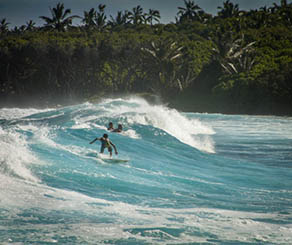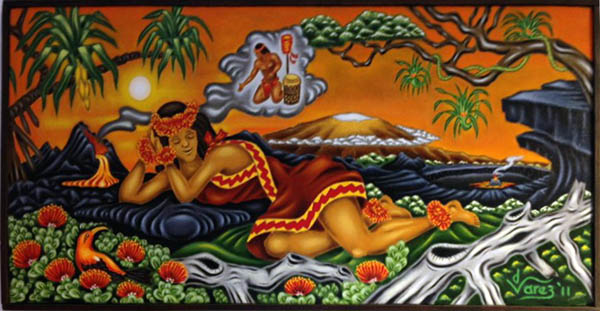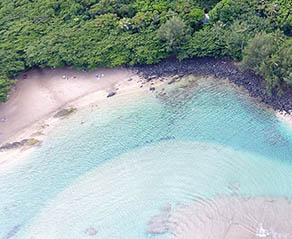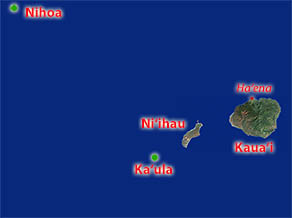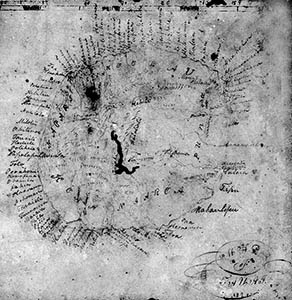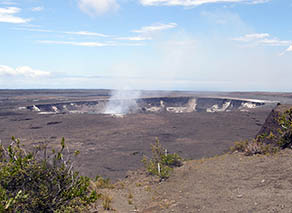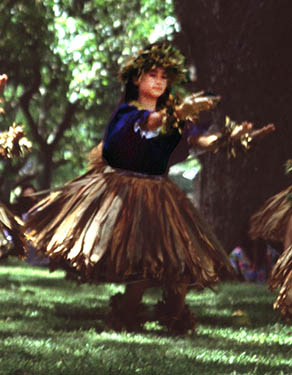| |||||||||||||||||||||||||||||||||||||||
 |
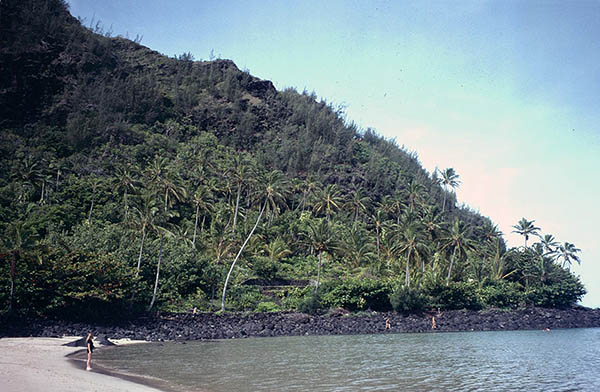
“The story is the same across the islands, but through our dance styles, it’s very different. The hula Ke Ha‘a la Puna I Ka Makani is noted as the first orally documented hula, but that is only applicable to islands from Hawai‘i to O‘ahu. And we know that because when we look at the mo‘olelo of Pele and Hi‘iaka, the story goes that she goes from island to island searching for a new home. She’s unsuccessful in Kaua‘i, moves onto O‘ahu, moves onto Maui, and eventually to Hawai‘i. There she’s successful, she creates a home.
“One day she invites her siblings to go down with her to the beach at Puna for a day of leisure, and surfing, and enjoying the waves in the beach. And so, they go down to Puna, and because she’s the queen bee, she gets her fill of waves first. And then when she is satisfied, she lifts the kapu on the ocean and everybody else can enjoy it. “It’s then that she tells her siblings that she is going to rest. Under no circumstances is she to be disturbed. The only two people that are given permission to disturb her sleep or awaken her are Hi‘iaka-i-ka-poli-o-Pele and one of the brothers. "Everybody understands that, and they go about their way. She goes down and prepares to rest. But before she does that, she teaches Hi‘iaka a hulihia. Hulihia are chants. She teaches Hi‘iaka this hulihia with the instruction that if her body is motionless for too many days, then this is the chant that she needs to do to draw her spirit back into her body. “Pele teaches the chant, the hulihia, to Hi‘iaka and then she goes into deep, deep, deep sleep. It’s at that moment that her kino wailua or her spirit leaves her body and begins to wander. We all do that. Our kino wailua leaves our physical body and that’s why we dream, because our spirit is going all over the place, and experiencing things, and connecting the people and places." Pele Dreaming, original oil painting by Dietrich Varez. “When her kino wailua leaves her body, it hears these unusual sounds. And so, she starts to pursue these sounds. ‘Where is it coming from?’ And she follows it, follows it. And every time she gets closer to it, it goes farther away. And before I know it, she’s left the reaches of Hawai‘i Island and have gone beyond Moloka‘i and Maui, and O‘ahu. And she’s getting closer and closer to it, but it’s just like an arm’s reach away, but it’s these pulsating sounds. It’s different. She’s never heard it before, but it’s mesmerizing, and it’s enticing. “She follows it and eventually that’s what brings her to Kaua‘i. And so, she follows the sounds all the way out northwest, and to Hā‘ena. When she arrives at Hā‘ena, she’s in her spirit form. She’s floating in air or whatever out over the ocean, and she sees that there’s this huge gathering on the beach at Kē‘ē. And so, at that moment, she lu‘u—she dives into the ocean. And when she emerges out of the ocean, she takes a human form of beautiful woman." “The throngs on the beach at Kē‘ē are multitudinous. There are hundreds and hundreds of people, and there’s a huge celebration of hula. And so, as she’s walking up the beach from the ocean, the crowds just part because people are just so baffled by her beauty. ‘Who is this woman?’ You know? “And she’s following the sounds, so she just walks, the crowds part, she gets to the front of the crowd, and there before her is Lōhi‘au Kauakahiapaoa, and other people in their company, and they’re behind the pahu. They’re behind the drums and they are chanting. So all of that stops and they have this eye contact, and he asks her. ‘Who are you? Where are you from?’ “And she says, ‘I’m from here.’ And he’s like, ‘Oh, no. You’re not from here because I know all of the beautiful women of Kaua‘i.’ Which he did. And he insists, ‘But I’ve never, ever seen you. So you cannot be from here.’ So they have this flirty cat-mouse thing going on. And they invite her to dance, and she said, ‘Oh, no. I don't want to dance. I don't want to dance, but I'll prove to you that I’m from Kaua‘i.’ And she begins to chant the winds of Kaua‘i. “So, in the mo‘olelo of Pele and Hi‘iaka, in the early part of the story, after she comes here and she meets Lōhi‘au for the first time, there is the wind chant. It’s called the Kaua‘i wind chant, but it actually starts at Nīhoa and to Kā ‘ula, and Ni‘ihau and then it comes across the Ka‘ulakahi Channel to Kaua‘i, and then she chants all the winds of Kaua‘i. She does that to convince him that she’s from Kaua‘i. Who wouldn’t be convinced? Of course, they’re all impressed and they believe. They have no idea they’re in the presence of a goddess. |
 |
|||||||
 |
 |
||||||||
 |
"There are at least 240 winds connected to every ahupua‘a from mountain to the sea: from breezes, to hurricane forces, to wind-blown rain, winds that carry rain, warm winds, cold winds, singing winds, all kinds of winds." “So just that part in the story, which is why mo‘olelo are so important. They’re not just stories. You have to look for the mythical truths that are in there, that really tells you what the bigger picture is. And just that mention of Pele’s experience is an indication that hula had not even reached any of these other islands. It was only existing on Kaua‘i at that time, which is the other reason and the other part that qualifies Kaua‘i’s claim as the original source of hula; is in that part of the story when they invite her to dance and she says, ‘Oh, no. I don't want to dance.’ She doesn't know how to dance. She has no idea. So that’s her cover up: ‘I don't know how to dance but I’m not going to give myself away. I’m going to chant the winds." "But the winds are part of her kinolau, because she’s a volcanic deity. So all the things that have to do with eruptions are very important, are her other manifestations. The storm forces, the different winds, the eruptions, the volcanic clouds, all of that are body forms of Pele. She’s very familiar with the winds because that’s how she creates islands. That’s what turns up all that energy before the eruptions and the explosions. She has that knowledge, but she has no knowledge of hula." "Pele and Lōhi‘au stay together three days and three nights, and before you know it, she begins to hear Hi‘iaka chanting the hulihia. That is when she tells him that she needs to leave and that she needs to return to Hawai‘i Island. She says she’s going to prepare a home for them and so to please, just be patient and wait. She will send someone to get him and to bring him to her once their home is prepared. “As quickly as she arrived, she disappears. After many days go by, this human being who has fallen deeply in love with this beautiful woman is heartbroken, refuses to eat. He’s just obsessed with her and begins to think that he will never see her again. Out of his grief, he takes his own life and he hangs himself from the rafters of his hale with his malo. It’s tragic. “When she goes back to Hawai‘i Island, she tells her siblings about her wondrous journey to Kaua‘i, and she cannot stop exclaiming about the beauty of the hula that she saw for the first time. She tells them, ‘Which one of you will dance the hula for me? I’m longing for it.’ All of her siblings all hang their heads down: ‘We don't know how to hula. We don't know nothing about that.’ 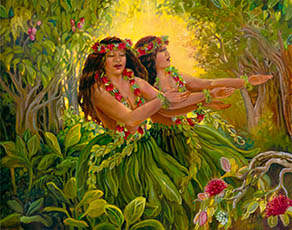
"But Hi‘iaka, on the other hand, steps forward and she says, ‘I will dance for you.’ And she has a friend named Hōpoe and they love being in nature together. Hōpoe is also a mentor and a teacher to Hi‘iaka, so she teaches her how to make lei. It’s also said that with her companion Hōpoe they observe the movements in nature and they mimic it. "And thus, Ke Ha‘a la Puna I Ka Makani is born as the first dance from them just mimicking the currents in the air, the wind and the sounds that it makes rustling through the hala groves, and the currents in the ocean, the tides, and the waves crashing on the shoreline, and the movements of the hala trees, the hala groves." “She offers that to Pele. Pele is thrilled because nobody else knows, and that’s the closest— not anywhere in comparison to what she witnessed on Kaua‘i, but she is most grateful that her sister has given her this humble and very beautiful offering. So then her second request to her siblings, ‘Which one of you will travel to Kaua‘i to fetch my dream lover Lōhi‘au’ “They all don't respond because they know it is a long, dangerous journey. But because of Hi‘iaka’s love and loyalty for her older sister, she volunteers to go on this journey to get Lōhi‘au. She’s the youngest. She has no experience. She has no idea at that point in her life that she even has mana, but she’s young, and eager, and volunteers to go." “Right before she leaves, she’s starting to feel a little apprehensive because she’s beginning to realize that she has no experience. But more so, she’s apprehensive about journeying alone. She goes up to the crater, a couple of times. The third time, she manages to draw up the courage to ask Pele for a companion. It’s a beautiful chant, and she tells her to please consider giving her a companion to travel with her because it’ll be a lonely journey. All she has right now is her shadow to keep her company. “That is how Pele decides to give her Wahine‘ōma‘o [another companion]. But before she leaves, the older brothers and Pele have a discussion, and the older brother, Kane, tells her, ‘You know, she really is young and has no experience. Frankly, I’m worried. We need to give her something to protect her.’ That is how the pā‘ū comes into the story." “Pele puts out a kāhea to all of the attendants of the Pele clan and she says that, "Hi‘iaka is going to travel. She needs to be outfitted with the perfect pā‘ū. So, they all set out to make the perfect pā‘ū and one-by-one, they go up and it’s either not made to perfection, or it’s not made well, or it doesn’t fit. Every one of the different pā‘ū are unsatisfactory until the last one. “The last one is made, in some versions, they say pā‘ū-o-palai, in some versions, they say pā‘ū-o-pala‘ā , and then in one of the versions, it could refer to her as Wahine‘ōma‘o. Anyway, that last skirt gets put on around her waist. It’s tied and it’s perfect. It’s made out of lā‘ī with palapalai or pala‘ā fern. In some versions, it’s palai, palapalai, in some versions it’s pala‘ā , but either way it’s the fern which is a kinolau of Hi‘iaka." “That is one of the first accounts of the tī leaf skirt. She finishes her skirt, and then it’s her turn to see if her skirt fits. She rolls the skirt into a bundle, puts it on her shoulders, and she, not crawls, but sort of duck-walks, approaching Hi‘iaka in the most humble gesture, and chants to her. "That chant that she does is a Kaua‘i. chant. It’s also a little hint about acknowledging where Hi‘iaka is going to travel to, but it also calls upon all of these different places that have mana and the power to protect her, whether it’s the waters, or important places.”
|
 |
|||||||




